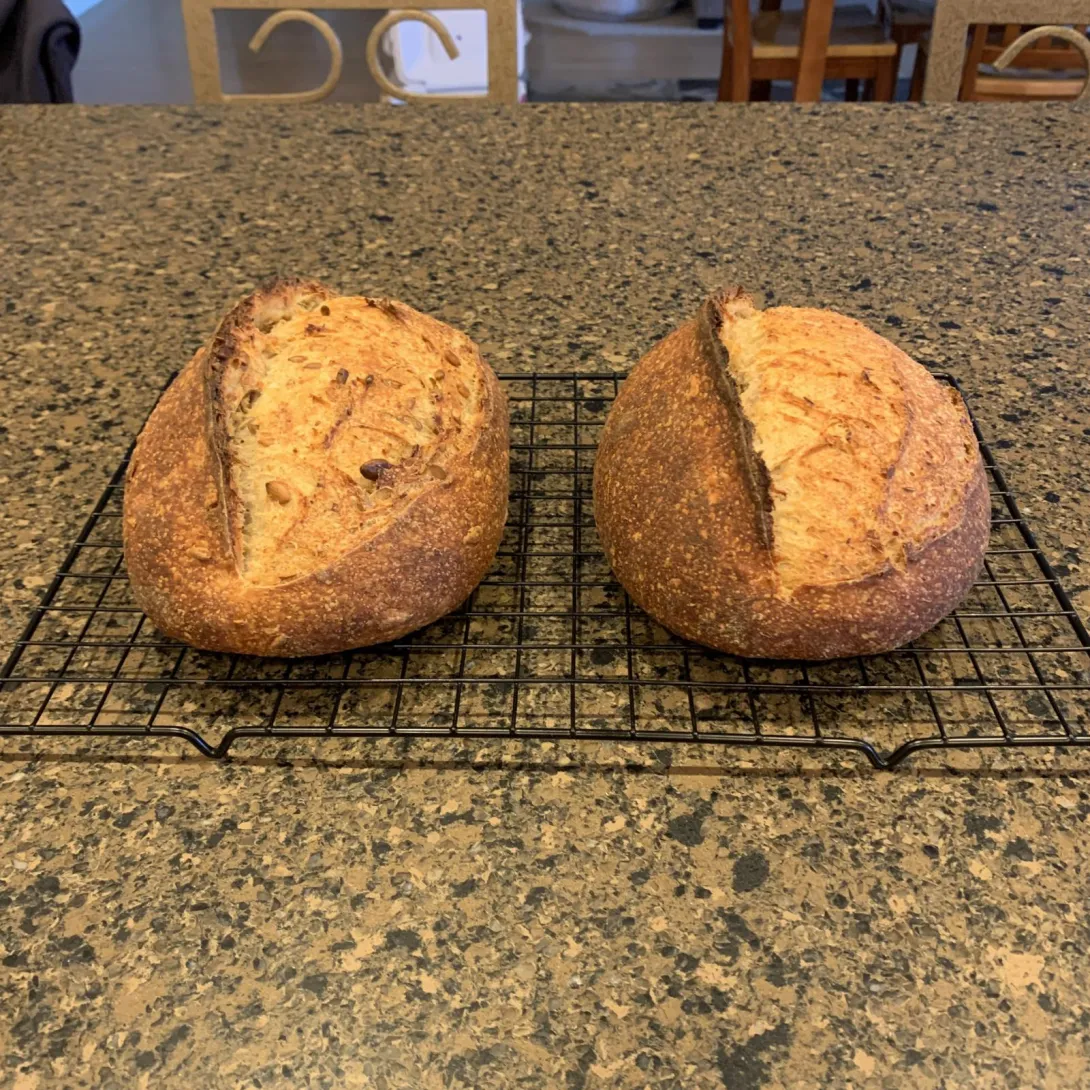
This is my take on a Finnish bread. I've changed it up quite a bit from the original, so I'm not sure I should even call it that anymore. For the most part, the ingredients are true to the recipe. However, this uses a 2-stage pre-ferment, a yeast water for leavening, and a mash. The original is a straight dough yeasted recipe.
Levain 1
22.5g Whole Rye Flour
22.5g Barley Flour (I used fresh milled Hulled Barley)
56.3g Yeast Water (recently refreshed and active)
1) Combine ingredients and ferment at 78-80 deg F for approximately 12 hours or until flours are bubbly and doubled
Levain 2
90.0g Bread Flour
25.2g Water
1.6g Sea Salt
1) Combine ingredients with all of Levain 1 and lightly knead into a dough. Ferment at 78-80 deg F until 2-3x in volume (6-8 hours)
Mash
22.5g Cracked Rye or Rye Chops
22.5g Barley Flour
22.5g Toasted Sunflower Seeds
22.5g Toasted Pumpkin Seeds
135.0g Whole Milk
1) Pre-heat Crockpot with 1-2" of water in it to 150 deg F using Inkbird Controller with probe in the water. Cover the Crockpot with two large towels to insulate it.
2) Combine dry ingredients in a bowl that has a tight cover
3) Warm milk in the microwave to 165 deg F. Keep it covered as much as possible to avoid evaporation.
4) Pour hot milk over dry ingredients, stir until fully wetted, cover tightly and place in Crockpot.
5) Allow ingredients to cook at 150 deg F for 3-8 hours (I went for about 6 hours overnight)
6) Set the Inkbird temp to 180 deg F and let cook until mash temperature reaches 180 deg F (1.5-2 hours)
7) Remove from Crockpot and let cool to room temperature
(Alternative: Replace sunflower and pumpkin seeds with 1 tsp of crushed fennel seed)
Final Dough
135g All Purpose Flour
135g Bread Flour
56.3g Yeast Water
109.8g Water
6.5g Sea Salt
1) Combine flours, yeast water, water, and Levain 2. Mix until flours are wetted. It will be on the dry side and stiff. This is needed to accommodate the mash hydration.
2) Fermentolyse 15-20 minutes
3) Fold in salt and mash in 4-5 increments. Thoroughly mix in the salt and mash using pinch and squeeze method. Rest 10 minutes.
4) Perform 4 sets of bowl kneading with 10 minute rests between sets. Bassinage in additional water as needed to get a supple dough.
5) Bulk ferment in an oiled bowl at 74-76 deg F.
6) Fold every 45-60 minutes until dough is feeling puffy. Allow the dough to bulk 80-100%.
7) Pre-shape and rest for 20-30 minutes
8) Gently shape and perform final proof at 78-80 deg F until jiggly and roughly doubled.
9) Pre-heat to 465 deg F; Bake in steaming oven for 1 minute at 465 deg F; 19 minutes at 425 deg F; vent oven; 20-25 minutes at 425 deg F or until a hollow thump
I made both the fennel and seeded versions for this bake. I wasn't able to get a crumb shot for either, but the fennel loaf was what you would expect for a loaf with 20% low gluten flour. Reasonably airy with an evenly distributed crumb and no large open areas.
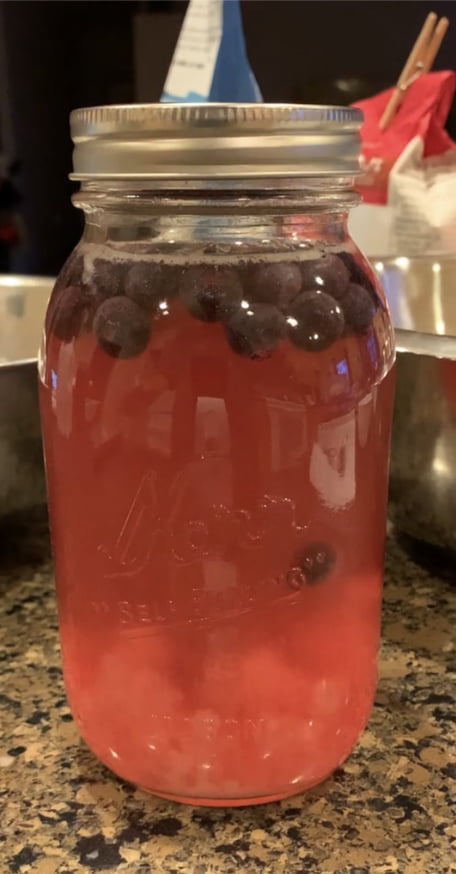
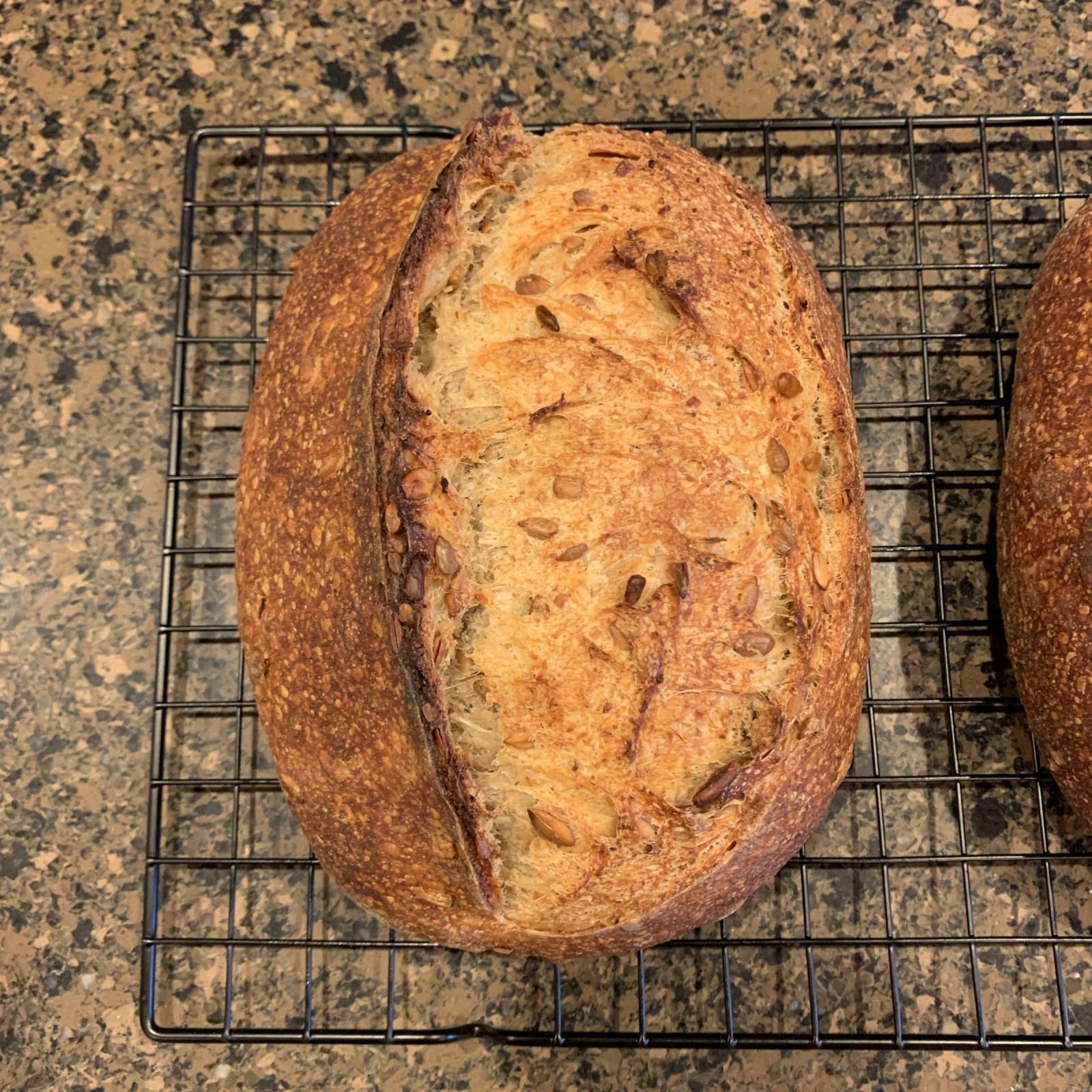
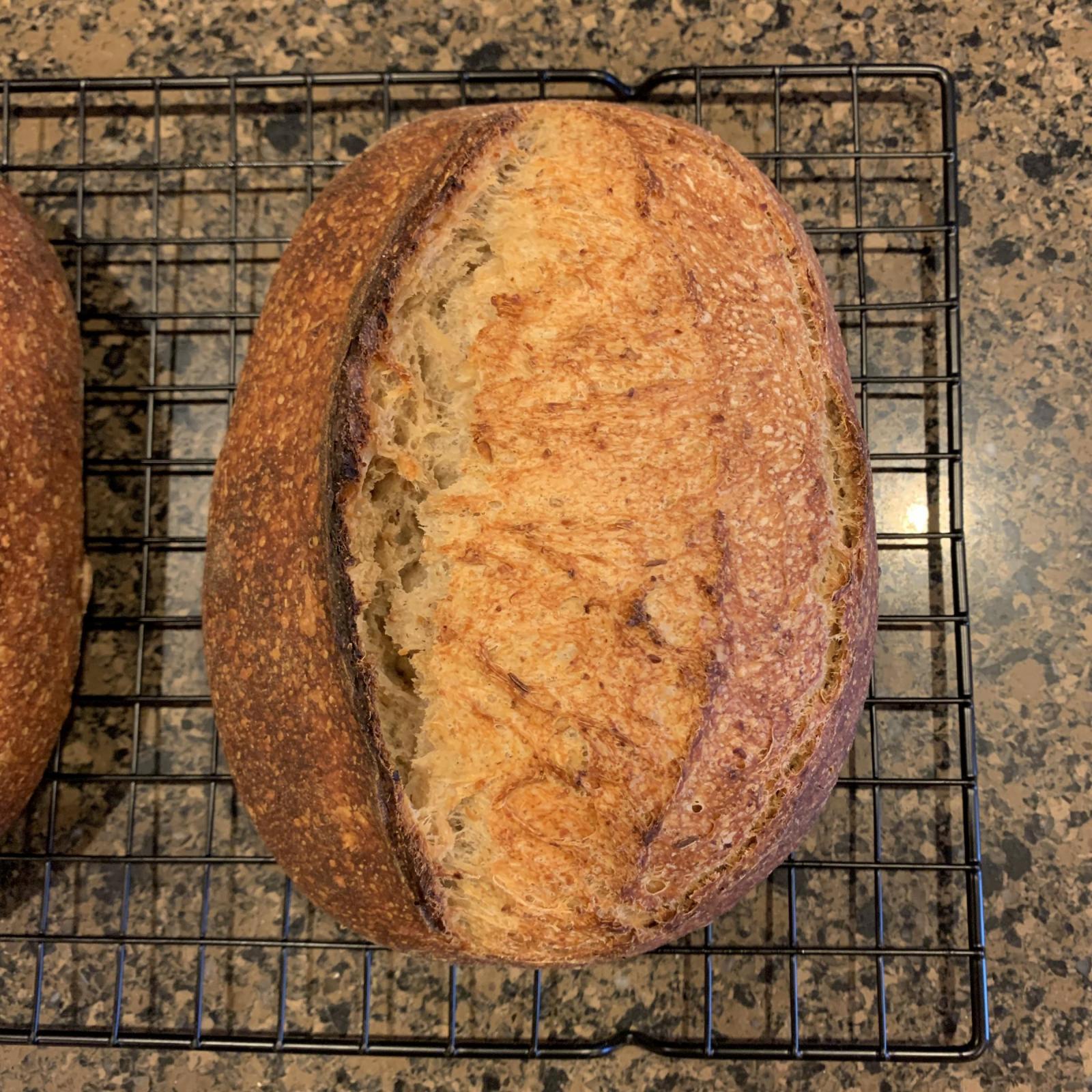
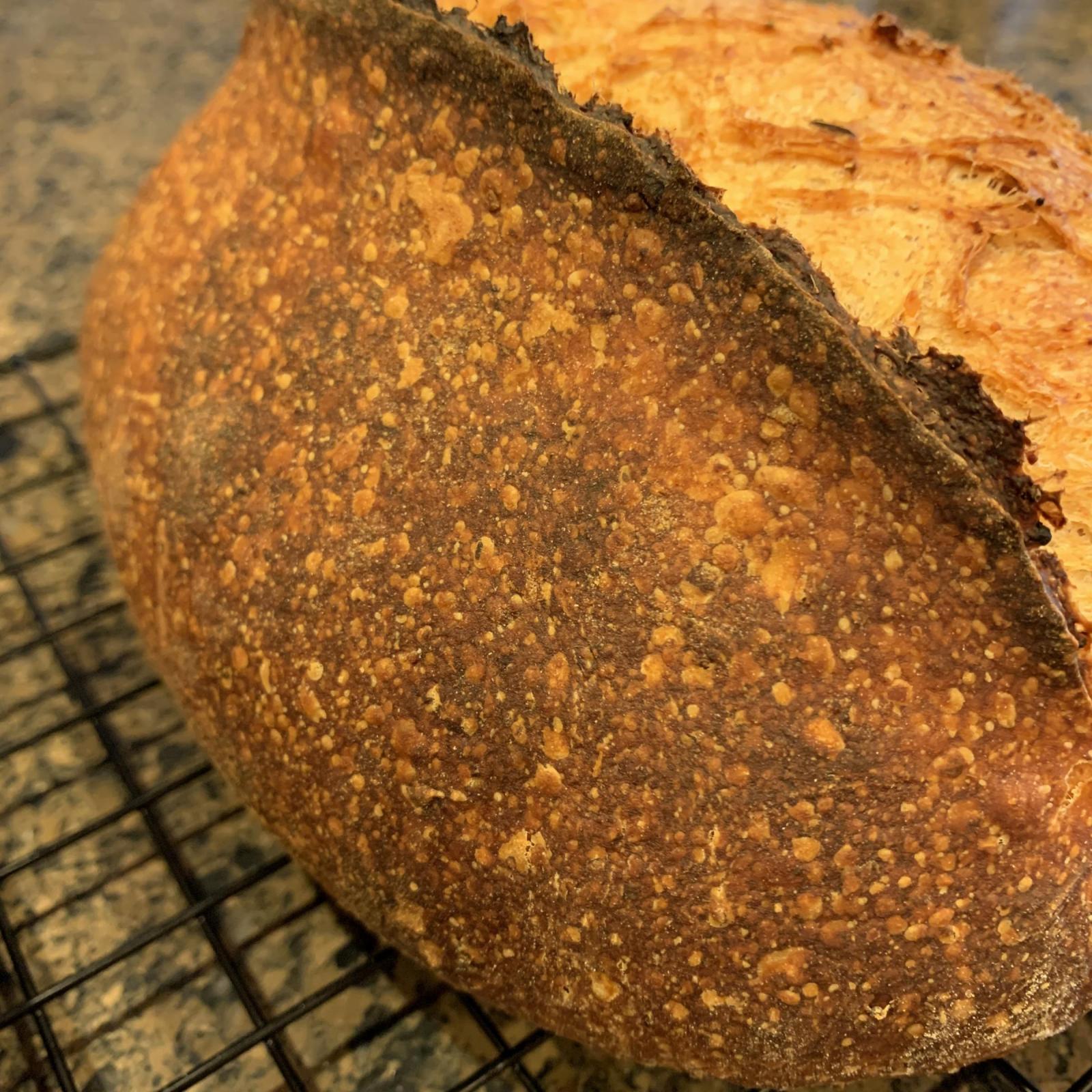
- HeiHei29er's Blog
- Log in or register to post comments
version, I can tell you that it is a delicious bread. It has a full, well-rounded flavor with highlights from the seeds and grains as they are chewed. The crumb, while firm, is also yielding and moist. And it is as pretty on the inside as it is on the outside, showing that the fermentation was well managed:
I've not had any YW bread previously but it is evident that Troy knows how to handle it.
Paul
Thanks Paul!
Gorgeous bakes Troy. I love your use of the yeast water and the mash. The flavour must be quite complex with everything going on. Paul is a lucky guy to have received that loaf.
Benny
Thank you Benny!
You can call it whatever you want. I'm not sure there really is "the original". Most modern day versions don't contain any rye or barley, but all are made with first clear flour. The oldest Finnish book I have that contains a very similar recipe was published in 1978. However, Ojakangas' book came out in 1964. I really want to track this recipe down now!
Thanks for posting this!
You’re welcome!
I did get my recipe from Ojakangas. The rye and barley portions should be higher, but I dropped them to keep the dough something I could handle as a hearth loaf. I may try it again with the original portions.
I don't think you need to worry about being able to handle the dough. Judging by this picture from the 70's, it doesn't have to be fancy:
This particular recipe is:
Thanks for posting this!
The proportions for rye and barley are the same in this recipe as the one Ojakangas published. I think I’ll bump them up to 20% each the next time I make it. 👍
This looks like a labor of love. The process is one that achieved a phenomenal result. It looks wonderful.
Wel done.
Gavin
Thanks Gavin. It does have a few moving parts but comes together pretty easily after making it a few times. 😉
That looks like an exemplar combination of beauty and taste as far as I can judge and imagine from pictures and description. Barley adds such a nice flavor to bread.
Thanks John and agree with you 100% on the addition of barley to a bread!
I have The Great Scandinavian Baking Book by the same author, dated 1988. I wanted to treat my dad, whose mother was Norwegian and an incredible baker. No doubt my father and grandmother would have been highly impressed by your wonderfully creative adaptation of a traditional recipe. Two levains, yeast water, and a mash! Very nice work.
Thanks AG!
And what a labour of love!
I must try a mash like you do in a bread at some point. And this one has made me sit up and take notice about barley flour, another one to add to my overflowing cupboard.
Thanks Troy
Thanks Jon!
If you don't want to source the flour, which isn't something you find everywhere, a "cornmeal or polenta" sized grind on hulled barley will work just fine. Barley is a wonderful grain to mash. Definitely enhances the flavor and natural sweetness of it in the bread.
Let me know if you do try it and have any last minute questions. The temperature control is the tricky part. Once you get that down, it's really just planning ahead and a few extra steps.